
MAY CONTAIN NUTS

Search Shorpy
SHORPY ART

Framed or unframed, desk size to sofa size, printed by us in Arizona and Alabama since 2007. Explore now.
Join and Share
Ad-Free Shorpy
Shorpy is funded by you. Patreon contributors get an ad-free experience.
Learn more.

Recent comments
- Alas, hidden from view
- Exclusive pump
- Details, Details
- What's that building to the left of the tower?
- Coal Barges
- Bromo-Seltzer
- Inner harbor
- The Basin
- What a headache!
- Giant stepladder?
- Baldwin 62303
- Baldwin VO-1000
- Cold
- No expense spared
- Tough Guys
- Lost in Toyland
- And without gloves
- If I were a blindfolded time traveler
- Smoke Consumer Also Cooks
- Oh that stove!
- Possibly still there?
- What?!?
- $100 Reward
- Freeze Frame
- Texas Flyer wanted
- Just a Year Too Soon
- WWII -- Replacing men with women at the railroad crossing.
- Yes, Icing
- You kids drive me nuts!
- NOT An Easy Job
Member Photos
The Shorpy
Print Emporium
Print Emporium
Search Shorpy
Search results -- 30 results per page
- Femmes Fatales: 1920
- ... two huntresses stalking small game. 8x6 glass negative by Christopher Helin. View full size.
Stowe Lake The hill in the background is Mt ... Posted by Dave - 05/19/2016 - 9:46pm -
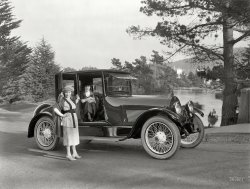
- The Black Hand: 1920
- ... the Shorpy Digest of Dingy Digits. 5x7 glass negative by Christopher Helin. View full size.
Fort Mason The touring car is parked on Van ... Posted by Dave - 11/27/2018 - 3:50pm -
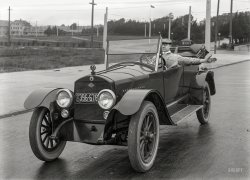
- Filles de Franklin: 1920
- ... was said to resemble a coal scuttle. 5x7 glass negative by Christopher Helin. View full size.
Interested in Franklins? Or any other ... Posted by Dave - 03/18/2015 - 4:24pm -
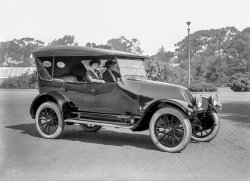
- A Close Call: 1920
- ... triple-strength spring-steel bumper. 5x7 glass negative by Christopher Helin. View full size.
That's it! Can't believe the person ... Posted by Dave - 02/06/2015 - 10:21am -
![A Close Call: 1920 No caption survives for this view of a circa 1920 Maxwell, but we would guess it had something to do with the car's excellent brakes, or maybe its triple-strength spring-steel bumper. 5x7 glass negative by Christopher Helin. View full size.
That's it!Can't believe the person below found the location of this picture. You can tell the fence and gate posts are an exact match. Bet it took a lot of work to get all that ivy off the posts. What a difference 95 years makes.
Franklin StreetThis is probably the 1700 block of Franklin in San Francisco. The low wall and short ornamental fence by the sidewalk are exactly the same. The brick gatepost with the sphere on top is exactly the same. The taller fence that extends from the gatepost is still there, but it is harder to see in the street view. Unfortunately, the street view does not show the parts of the house that are shown in the photograph above, but the house is made of brick, and the details of the window-frames are similar.
I submitted a post a few months ago about the photograph Up From the Ashes, in which I said that at least two of the houses in that photograph were still standing. This house happens to be the first one I mentioned there.
View Larger Map
Uh! Guys!I think we are in danger.
Could be 1922I've got a vision. I suppose it's 1922. If someone can acknowledge, would be cool.
[The car has a 1920 license plate. - Dave]
What me worry?What a determined expression the driver displays!
I could've made it!... if it weren't for those meddling kids!
(The Gallery, Cars, Trucks, Buses, Chris Helin, Kids, San Francisco)](https://www.shorpy.com/files/images/SHORPY-219-01.thumbnail.jpg)
- Municipal Hygiene: 1919
- ... by Shorpy from large-format negatives taken by or for Christopher Helin, travel and automotive editor of the San Francisco Examiner from ... Posted by Dave - 01/09/2015 - 8:30pm -
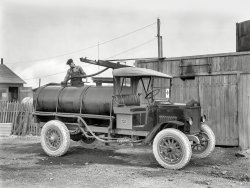
- Tin and Bones: 1920
- ... somewhat skeletal if you ask us. 5x7 glass negative by Christopher Helin. View full size.
Muffler Bearing I believe the muffler and ... Posted by Dave - 05/13/2015 - 4:18am -
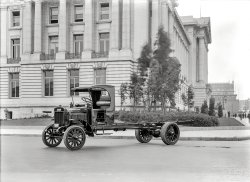
- A Bush in the Hand: 1920
- ... -- MacRorie-McLaren Co. nursery." 5x7 glass negative by Christopher Helin. View full size.
Not a very dry place for Riding the Storm ... Posted by Dave - 08/24/2015 - 2:34pm -
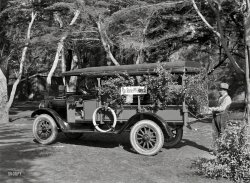
- Health Deputy: 1924
- ... "Oiling & Greasing." 6½ x 8½ inch glass negative by Christopher Helin. View full size.
Next Door Interesting to see the two workers ... Posted by Dave - 12/15/2014 - 2:45pm -
![Health Deputy: 1924 San Mateo County, California, 1924. "Daly City Deputy Health Officer and construction trucks." Also the quarters of the Constable, not to mention "Oiling & Greasing." 6½ x 8½ inch glass negative by Christopher Helin. View full size.
Next DoorInteresting to see the two workers in the building on the right, a blur as they work -- one in the top window and the other coming out the front door.
Also some posters on the windows in the next building reading "Crowe." Maybe a local election?
[His platform was Transparency. - Dave]
The ConstableThe constable in 1924 (and for many years prior) was one Silvio Arthur Landini. Born in California in 1876, he appears to have served for many years as constable for Daly City before growing ill after partaking in a fad diet and dying in 1935.
No, seriously.
From the Santa Cruz News, March 6, 1935.
The Constable and the Crime Shack"No one knew more about criminal activity at the "Crime Shack" than Colma Constable S.A. Landini."
And don't forgetto get your crankcase serviced.
Ventura Motor OilOn the building to the far right.
Authentic bitsNote the Dodge "C" cab rack bodied express has flat rear fenders from a non Dodge. The Dodge roadster on the far left has the boldly crowned correct Dodge rear fenders that match the style of the front fenders of the truck. That being said, the four cylinder Dodge of this type was an excellent vehicle.
(The Gallery, Cars, Trucks, Buses, Chris Helin, Medicine, San Francisco)](https://www.shorpy.com/files/images/SHORPY-166-01.thumbnail.jpg)
- Merry Old Cole: 1919
- ... how. The yard last seen here . 5x7 glass negative by Christopher Helin. View full size.
Two doors, one wide aisleway with all due ... Posted by Dave - 04/28/2015 - 10:54am -
![Merry Old Cole: 1919 San Francisco, 1919. "Cole auto." Climb in, if you can figure out how. The yard last seen here. 5x7 glass negative by Christopher Helin. View full size.
Two doors, one wide aislewaywith all due respect to fellow Shorpy enthusiast T. Water, this beautiful little roadster was in fact a 2-door called the Cole 861 Tuxedo Roadster, which according to a factory ad was "A perfect dream." It has the snappy double-cowl design, "with rear compartment access...provided by a wide aisleway between the front seats." Plus, it was powered by a "giant 70 horsepower" V8 displacing a whopping 5.7 liters.
The addressTaken in front of the still extant 1701 Franklin Street.
IngressDoor latch is probably on the inside. It is a roadster which has no side windows and outside one is not really needed.
[The question is how to get into the back seat. See above. - Dave]
Three DoorsThe Cole was a high-end V8-powered car. This car had three doors. One driver's side and two passenger side. It was not an entirely uncommon body style. Many municipalities had laws regarding entering or exiting a car on the street side.
(The Gallery, Cars, Trucks, Buses, Chris Helin, San Francisco)](https://www.shorpy.com/files/images/SHORPY-324-01.thumbnail.jpg)
- Perfect Timing: 1929
- ... 1929." It's all downhill from here! 5x7 glass negative by Christopher Helin. View full size.
I wish ... some really rich person would buy ... Posted by Dave - 02/22/2015 - 2:55pm -
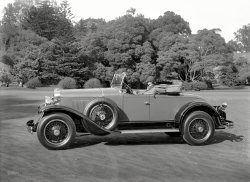
- Diana Eight: 1926
- ... Pantheon of Forgotten Phaetons. 5x7 glass negative by Christopher Helin. View full size.
Hope it's cold Wool overcoat, gloves, ... Posted by Dave - 03/07/2015 - 11:31am -
![Diana Eight: 1926 San Francisco, 1926. "Diana 8 at Civic Center." The short-lived Diana, a car for the ladies and one the more obscure entries in the Shorpy Pantheon of Forgotten Phaetons. 5x7 glass negative by Christopher Helin. View full size.
Hope it's coldWool overcoat, gloves, hat and a 3 piece suit.
[Natives know how to dress for San Francisco summers. -tterrace]
More Great Menswear!Once again, an automobile photo that doubles as an excellent menswear photo! As I have noted here before, classic men's business wear and grooming simply haven't changed very much in 100 years. The hat is the only marginally "period" element in the garb of either of these men. Even including the hat, you could find their exact equivalents walking down Wall Street this coming Monday morning.
TodayThis is the "plaza" side of what since 1966 has been the Asian Art Museum. Lots of those windows have been cut out to form doors (fire codes, yanno), and man, but I do prefer the older, prettier streetlamp.
Three observations1. The men sitting on the bench/wall across the street are separated by almost the same distance of space, as if someone measured how much space they should each have around them; no crowding.
2. The man standing closest to the car in the Fedora and overcoat is immaculately dressed in very finely tailored, perfectly fitting clothing, sign of an impeccable haberdasher.
3. The hood ornament is impossible for my old eyes to see. Is it possible to get a close-up?
Thank you.
Interesting hood ornamentWould that be Lady Diana?
[In Greek mythology, the goddess of the hunt. -Dave]
And the service manual tooThere's a copy of the service manual for the 1925 - 1928 Diana available online: http://www.oldcarmanualproject.com/manuals/Moon/Diana/index.htm
Esoteric MarqueBut good looking withal.
Some Things Never Go Out of StyleMy dad was wearing an overcoat just like the one in the photo over 40 years after the picture was taken. I wouldn't be surprised if he purchased it around the time the guy wearing one in the shot, signed the papers for the car.
(The Gallery, Cars, Trucks, Buses, Chris Helin, San Francisco)](https://www.shorpy.com/files/images/SHORPY-263-01.thumbnail.jpg)
- Yuen Hing & Co.: 1921
- ... with our previous Speedwagon . Glass negative by Christopher Helin. View full size.
Musically speaking, We're on Grant Avenue, ... Posted by Dave - 05/01/2015 - 2:05pm -
![Yuen Hing & Co.: 1921 "REO Speedwagon grocery truck, San Francisco, 1921." Compare with our previous Speedwagon. Glass negative by Christopher Helin. View full size.
Musically speaking,We're on Grant Avenue, San Francisco, California, USA.
[Most interesting. I wonder how one would travel there. - Dave]
[Ideally in a trolley, but you have to settle for a cable car. -tterrace]
Weather-beatenLots of mud splatters. Could be from riding the storm out.
Can't fight this feeling anymore...I like this truck.
Stopping distanceI wonder what the stopping distance was for one of these trucks when fully loaded, using rear wheel only mechanical brakes, on a steep San Francisco hill. Lots of smoke, then right into the Bay!
Having Learned To Drive in San FranciscoOne learned quickly the streets that were too steep to comfortably drive. Trucks, unless they were delivering locally, were usually banned from streets like Divisadero (seen in the movie "Bullit"). These delivery trucks usually had a "granny gear" which was a very low 1st gear and would hold the vehicle to a crawl when descending steep hills. Brakes were not usually needed.
Chinatown Telephone ExchangeOn the side door of the truck you can see the letters "PHONE CHINA" and the beginning of a numeral. San Francisco's Chinatown had its own telephone exchange from 1887 until the 1940s when dial phones replaced the switchboard operators. How it all worked is explained here.
A Hundred Million Miracles"Grant Avenue San Francisco" was in Rodgers and Hammerstein's Broadway hit "Flower Drum Song" from 1958. The film version released in 1961 was nominated for 11 Academy Awards.
Western street with Eastern manners,
Tall pagodas and golden banners,
Throw their shadows through the lantern glow.
You can shop for precious jade
or teakwood tables or silk brocade
Or see a bold and brassy night club show,
On the most exciting thoroughfare I know --
Grant Avenue, San Francisco,
California, U.S.A.
Looks down from Chinatown
Over a foggy bay.
You travel there in a trolley,
In a trolley up you climb,
Dong! Dong! You're in Hong Kong,
Having yourself a time.
You can eat, if you are in the mood,
Shark-fin soup, bean cake fish.
The girl who serves you all your food
Is another tasty dish!
You know that
You can't have a new way of living
Till you're living all the way
On Grant Avenue --Where is that?--
San Francisco, That's where's that!
California, U.S.A.!
(The Gallery, Cars, Trucks, Buses, Chris Helin, San Francisco, Stores & Markets)](https://www.shorpy.com/files/images/SHORPY-326-01.thumbnail.jpg)
- Waitin' Phaeton: 1928
- ... unusual center-hinged doors. 5x7 inch glass negative by Christopher Helin. View full size.
Re Linkage Looks more like to a hand control ... Posted by Dave - 09/27/2016 - 11:53pm -
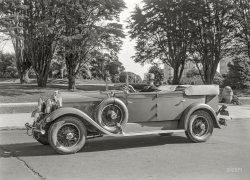
- King Coupe: 1920
- ... Shorpy Gallery of Jinxed Jalopies. 5x7 glass negative by Christopher Helin. View full size.
Distressed ingress It must have been ... Posted by Dave - 10/28/2016 - 3:16pm -
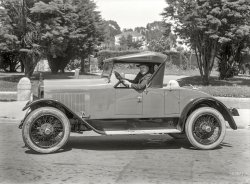
- Car & Drivers: 1919
- ... When a Caddy just isn't enough. 5x7 glass negative by Christopher Helin. View full size.
Classy setting It looks like a scene from ... Posted by Dave - 02/01/2016 - 9:59pm -
![Car & Drivers: 1919 1919. "Paige touring car at San Francisco Golf Club." When a Caddy just isn't enough. 5x7 glass negative by Christopher Helin. View full size.
Classy settingIt looks like a scene from Downton Abbey.
Shingles Why do they look like they were put on by 8-year-olds?
[They're imitating the thatched roof on an English cottage. - Dave]
Bearly possibleThat appears to be an image of the California grizzly bear on the license plate, an homage to the short-lived Bear Flag Republic of 1846. Could that bear alternatively indicate that the car's owner is an alumnus of UC-Berkeley and its Cal Bears? I don't know whether association plates were offered that long ago.
[It's a star. Between 1916-1919 the image indicated the year of the plate's registration: 1916-bear; 1917-poppy; 1918-Liberty Bell; 1919-star. -tterrace]
Club house todayCurrent view of club house.
Car DoorsThose small doors make the Paige look even bigger. Easy to see why rear doors are small, but why didn't Paige make the front doors larger. Tight squeeze getting behind that steering wheel.
(The Gallery, Cars, Trucks, Buses, Chris Helin, San Francisco)](https://www.shorpy.com/files/images/SHORPY-889.thumbnail.jpg)
- Trucks Entering Highway: 1931
- ... of the surrounding terrain. 8.5 x 6.5 inch glass plate by Christopher Helin. View full size.
South San Francisco area? Those hills seem ... Posted by Dave - 09/17/2014 - 6:51pm -
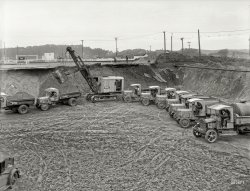
- Custom Bodies: 1924
- ... at the Royal: "Single Wives." 5x7 glass negative by Christopher Helin. View full size.
Gillis Brothers. They later moved out to ... Posted by Dave - 01/21/2016 - 1:37pm -
![Custom Bodies: 1924 San Francisco, 1924. "Pierce-Arrow autos at Gillig Bros." Specialists in Body Building, Seat Covers, Auto Painting and Upholstery. Now playing at the Royal: "Single Wives." 5x7 glass negative by Christopher Helin. View full size.
Gillis Brothers.They later moved out to Hayward. I rode on many of their school buses back in the day.
Google eyesYou can always spot a Pierce-Arrow by the headlamps built into the front fenders. Definitely a car for the well-to-do, even if they were regular factory models.
[The ones here seem to have been stretched, with an extra row of seats. - Dave]
2015 GilligStill in business, but vehicle is a bit larger!
Crown or GilligIf you rode a school bus in the last 40 years on the West Coast, it was either one or the other.
Pass on the MoviesPhotoplay does not think much of the films at the Royal:
Single Wives -- Once again the wife-neglected-by-her-business-mad-husband theme reappears...Reminiscent of a thousand films and has as its only interest the orchidaceous Corrine Griffith. Considerable bad acting surrounds her. (Photoplay, October 1924)
For Sale -- Stock Plot 2A: the girl who is put upon the matrimonial auction block to save her bankrupt father....Obvious tale with artificial "big scenes". (Photoplay, September 1924)
Right-hard drive?Why are all three of these vehicles right-hand drive? Are they, or were they, part of an export order to New Zealand or Australia, where big custom-bodied American limousines were favored for use on sparsely populated and largely unpaved rural routes? The rear two cars, at least, seem to have more than the normal amount of ground clearance, which suggests that they might be, or have been, intended for export to Down Under.
The photos are not reversed; the signage on the building and the license plates read normally, and the car in the background is (as one would expect in the USA) left-hand drive.
Is There Something Missing from the Fire Escape?How would one get to the sidewalk from the lower fire escape platform ?
Most I've seen have a vertical ladder which slides down or a stairway which pivots down, both with counterweights to hold them in the up position.
John Ruth
(The Gallery, Cars, Trucks, Buses, Chris Helin, San Francisco)](https://www.shorpy.com/files/images/SHORPY-878.thumbnail.jpg)
- Sleeps Two: 1920
- ... Equipped with what seems to be a bed. 5x7 negative by Christopher Helin. View full size.
Who packed the shovel? Hank and Maggie off to ... Posted by Dave - 10/09/2014 - 6:02pm -
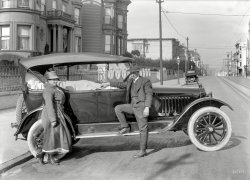
- Geared to the Road: 1924
- ... car's gigantic Miller Cord tires. 5x7 glass negative by Christopher Helin. View full size.
I don't think ... ... the doors were ... Posted by Dave - 05/23/2019 - 2:23pm -
![Geared to the Road: 1924 San Francisco circa 1924. "Hudson Super Six touring car at Spreckels Mansion." Plucked from the Shorpy Pantheon of Pharaonic Phaetons. Our title comes from the slogan on the car's gigantic Miller Cord tires. 5x7 glass negative by Christopher Helin. View full size.
I don't think ... ... the doors were poorly fitted. I think that's the way they were designed to look. Also I don't think that was a single brake light. I think it was just a reflector like they have on bicycles.
[It's a lamp with an electric bulb. - Dave]
MonochromeI'd love to see this colorized. In its present condition, it almost looks like Pershing's spare staff car.
No Okies HereAlthough it was a Hudson Super Six of this vintage that years later purportedly carried the semi-fictional Joads from Oklahoma to California in "The Grapes of Wrath," it is extremely unlikely that theirs featured double-sided whitewalls or full spare wheels (as opposed to merely the demountable rims). Nor was their Hudson likely to have bristled with padlocks like the photo car -- quite an oddity considering that anyone possessing a short length of wire could have made off in minutes with the entire vehicle.
Just for hooligansThe spare tire has a padlock. I didn't know that feature was required then.
We just love rooting through customers' cars looking for the key for the locking lug nuts. In a perfect world, the last people that touched it put it back where it belongs.
Once in a while we will get a car owned by a packrat. Stuff piled to the ceiling, with who knows what living under the pile of magazines and old food. The trunk is usually stuffed too, and the key is buried somewhere in there.
No one really steals alloy wheels anymore so we usually use our special tool to get the locking lug nut off, and install four new lug nuts to match the others.
Give me a brakeCheck out the puny single brake light, placed low where no one will see it.
Several degrees from ElvisThe Spreckels mansion was designed by George A. Applegarth for Adolph B. Spreckels, an heir to the Spreckels Sugar Co. fortune. At 2080 Washington Street, it is currently the home of romance novelist Danielle Steel. Judy Spreckels, the ex-wife of Adolph Jr., became a huge fan of Elvis Presley, traveling and hanging with him and his entourage in LA, Vegas and Memphis.
OdditiesI suppose the padlock on the sidemount spare might have been justified, but it is curious that the one on the external trunk is used not to protect the contents but rather to keep the entire trunk secured to the vehicle. I also had not noticed before the vertical bars between the trunk and the rear of the car body, presumably to prevent movement of the trunk from damaging the body panels.
The other thing that is revealed by the shadows is the shockingly poor fit of the doors, which seem to jut out at the bottom from the body structure itself. Odd on what is otherwise an impressive-looking vehicle.
Trunk or bootI see why we still call that space in the back of our cars a trunk. It was a trunk. So why do the British call it a “boot?” Perhaps someone can enlighten me.
[The boot locker was where your coachman or driver kept his boots. - Dave]
(The Gallery, Cars, Trucks, Buses, Chris Helin, San Francisco)](https://www.shorpy.com/files/images/SHORPY-1389.thumbnail.jpg)
- Initialized: 1922
- ... the monogram of one C.E.M. 5x7 inch glass negative by Christopher Helin. View full size.
Dual Cowl This was known as a dual cowl ... Posted by Dave - 08/17/2016 - 8:44pm -
![Initialized: 1922 San Francisco circa 1922. "Simplex, Public Library." Wearing the monogram of one C.E.M. 5x7 inch glass negative by Christopher Helin. View full size.
Dual CowlThis was known as a dual cowl phaeton. It was a body style offered by most of the high end automobiles until the early 30s when they fell from favor. Some certainly were chauffeur driven, but they were not intended as livery vehicles
Missing HandleThe back door handle is missing. How did they get in?
Missing Handle FoundThe rear cowl, which was hinged at the back of the front seat, also acted as the latch for the rear doors. There was a release handle that unlocked the cowl, which was then lifted and the doors could be opened, allowing ingress to the rear seat
C&M not CEMI believe that is an English version of an ampersand (&), not a capital E. It looks very much like a modified English Pound sign, or a soft-cornered capital E, sometimes with a curl on the lower bar or an E with acute and cedilla marks.
[Nope. - Dave]
Company car?Interesting back seat. Would this be a Company driver, or a limo of some sort?
More about CEMI believe CEM = Carlton Earle Miller, of San Francisco and San Mateo. Car is a 1917 Simplex Crane.
[This reference to his "Circle Anchor" ranch certainly seems compelling. -tterrace]
(The Gallery, Cars, Trucks, Buses, Chris Helin, San Francisco)](https://www.shorpy.com/files/images/SHORPY-1017.thumbnail.jpg)
- We Really Must Be Going: 1917
- ... of things, not a moment to spare! 5x7 glass negative by Christopher Helin. View full size.
Merrily We Roll Along Since Hugh (Woo-Woo!) ... Posted by Dave - 05/11/2018 - 12:09am -
![We Really Must Be Going: 1917 UPDATE: Commenter 426hemi has identified our mystery ride as a 1917 Olympian Motors "Tourist" touring car. The Olympian, made in Pontiac, Mich., lasted from 1917 to 1921; the image above might be, as far as the Internet is concerned, one of the very few (if not only) surviving contemporary photographs of this rare bird.
Circa 1917 San Francisco is the backdrop for this unlabeled shot of four motorists in their anonymous auto, bound for points unknown. With, by the look of things, not a moment to spare! 5x7 glass negative by Christopher Helin. View full size.
Merrily We Roll AlongSince Hugh (Woo-Woo!) Herbert seems to be along for the ride, perhaps they're on their way to Warner Bros. for a Busby Berkeley musical or a Merrie Melodies cartoon.
A Whatzit.Come on people, somebody's got to identify this thang. My first guess is a Star built by Durant; a smallish inexpensive, light, no frills car to compete with the Model T.
[We already have several examples of the Star Car on these pages, none of which match this vehicle. Which also lacks the Star Car's star hubcaps. - Dave]
Cellular distractionsIt's clear the front and rear passengers are distracted by their status updates on Facebook.
Five LouversSeems similar to 1916-1917 Detroiter Automobiles, fender lines look the same, door shapes, angled windshield, wheels, hubs, etc., only difference I see is sharper radiator lines in this pic. Possible different year. Not many have only five large louvers.
Could it bea Saxon Six?
I would say that ...This 5 seater is a 1917 Olympian Tourist Touring car.
Unfortunately, I couldn't find any photos of this model, but based on this advertising illustration, the car had similar details including the spotlight, and moreover, other 1917 Olympian models sported five vertical hood louvers.
[Excellent detective work! - Dave]
AdvertisingA lot of automobile companies went bankrupt before they discovered advertising with pretty girls.
It's alive. It's ALIVE!Well, at least on display, rather. The very rare 1917 Olympian Tourist as part of the private Mark Thomas collection here in Michigan. Thomas has made it his stated goal to collect at least one of the 13 different makes that have hailed from his hometown of Pontiac over the past century plus. And he has the Olympian on display.
More OlympiansMark Thomas actually owns two Olympians, and it's possible that there may be others. The 1957 Register of Antique Automobiles shows that there were at least three known at the time of publication.
The Olympian Dealer in San Francisco was the California Motor Sales Company at 1319 Van Ness Avenue.
During World War I, Olympian produced aerial bombs for the U.S. Government. They also made an armored car in hopes of selling additional examples to the U.S. military, but it appears that none were actually sold. Instead the vehicle shown below was used to help sell Liberty Bonds during the third bond drive in 1918. A couple of Olympian coupes, both open and closed, are also shown below.
The Olympian ceased production in 1920, it then became the Friend for 1921, and then it became defunct. Olympian production is thought to have been approximately 2,070 cars although some sources estimate up to 3,000. Friend production was approximately 50 autos, and at least one still exists.
(The Gallery, Cars, Trucks, Buses, Chris Helin, San Francisco)](https://www.shorpy.com/files/images/SHORPY-1315.thumbnail.jpg)
- Clamshell Coupe: 1924
- ... bet that house is finished by now. 5x7 glass negative by Christopher Helin. View full size.
Tire size The tires appear to be 32x4 (4 ... Posted by Dave - 04/24/2015 - 8:51pm -
![Clamshell Coupe: 1924 San Francisco circa 1924. "New Reo Six, Pacific Heights." We'll bet that house is finished by now. 5x7 glass negative by Christopher Helin. View full size.
Tire sizeThe tires appear to be 32x4 (4 inches wide on a 32-inch rim). Does anybody know what the 105 / 610 number represents?
[Size in millimeters. - Dave]
Business CoupeWas this the so-called "salesman's coupe" for its ability to carry a lot of samples in a huge trunk?
Shocked by the narrow whitesI thought narrow whitewalls were a new thing when they suddenly (re)appeared in 1962. Apparently not.
Weird measurements105mm is about 4.134 inches (i.e., close enough to 4 for tire purposes); but 610mm is about 24.016 inches, which is pretty far from 32 inches.
[24 inches is the rim size for a 32x4 tire (32 minus 4x2 equals 24). - Dave]
Washington & OctaviaBased on the concrete stairs and the steep angle. The house is there but now behind two others.
(The Gallery, Cars, Trucks, Buses, Chris Helin, San Francisco)](https://www.shorpy.com/files/images/SHORPY-321-01.thumbnail.jpg)
- Scout Kar: 1918
- ... 1918 Washington State dealer plates. 5x7 glass negative by Christopher Helin. View full size.
What car? All I see is a bunch of Trees.
... Posted by Dave - 11/11/2014 - 7:38pm -
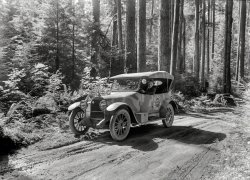
- Cruel Shoes: 1918
- ... footwear on the left. 5x7 glass negative by Christopher Helin. View full size.
Time here stands still...
Sharp ... Scottie in the back seat.
(Cars, Trucks, Buses, Chris Helin, San Francisco) ... Posted by Dave - 08/17/2015 - 1:06pm -
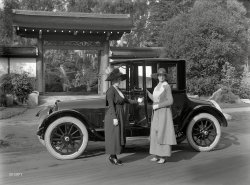
- Hauling Ice: 1934
- ... A business that was melting away. 5x7 film negative by Christopher Helin. View full size.
What's an Icebox? Even after ... Posted by Dave - 11/12/2014 - 5:37pm -
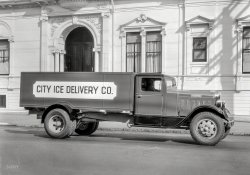
- Fox Trap: 1915
- ... Park." Note the curved side glass. 5x7 glass negative by Christopher Helin. View full size.
Brakes on the front At the rear wheel, the ... Posted by Dave - 11/28/2015 - 11:49am -
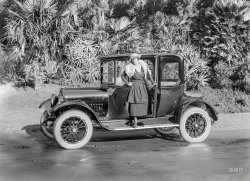
- Our New Olds: 1930
- ... With Olive Oyl and her sister, Baby. 5x7 glass negative by Christopher Helin. View full size.
Black tires! They must have Armor-All'd them ... Posted by Dave - 10/13/2015 - 6:22pm -
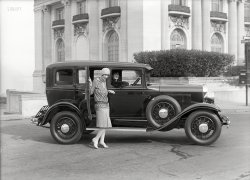
- Naked Truck: 1919
- ... the Shorpy List of Lapsed Lorries. 5x7 glass negative by Christopher Helin. View full size.
Seatbelts ON! Just think, this truck has ... Posted by Dave - 10/04/2017 - 1:49pm -
![Naked Truck: 1919 San Francisco circa 1919. "Sandow motor truck." Latest entry on the Shorpy List of Lapsed Lorries. 5x7 glass negative by Christopher Helin. View full size.
Seatbelts ON! Just think, this truck has solid rubber tires, providing no cushioning that pneumatic tires would provide, has no shock absorbers to speak of, and no seat belt. The beefy leaf springs don't look as if they would flex much on each pothole. The only cushioned thing is the horsehair he's sitting on. The driver must have had to hang onto the steering wheel to stay seated. Lacking a windshield, if that bowler is not jammed on tight, it might take flight, but driving at night must have been difficult by kerosene light.
But each wheel spoke has pinstripes.
GreatRadiator; very distinctive and memorable. Regarding windshields and such, sure most of those items would be part of the final vehicle design as specified by purchaser.
BTW, wonder if Sandow was the same strongman featured by Flo Ziegfeld and depicted in the movie The Great Ziegfeld. Probably so, interesting factoid.
Pretty awesomeThere is virtually no information extant these days on this Sandow truck, which is a pity. The rear suspension is very advanced for the time, and better than what you get on a five-ton truck today!
The springs are not required to do anything but be springs. Location of the axle fore and aft is by huge trailing arms, and a Panhard rod locates it laterally. The usual arrangement is for the leaf springs to do both as on brand new Ford and Chevy pickups and medium duty Navistars, and it isn't elegant mechanically.
The rear axle itself is a worm drive from an outside supplier, quite common at the time. Nice photograph by Helin, the Hearst motoring and travel writer from 1915 to 1929, who seems to have done quite well for himself.
http://yosemiteblog.com/2011/03/28/a-look-back-at-yesteryears/
PinstripesNo greasy t-shirt for this truckie! (Yes, I realize it's a publicity shot, and he's probably the regional sales manager, trying to look like he's doing real work)
A Strong NameProbably named after Eugen Sandow (1867-1925), the pioneering German bodybuilder and legendary strongman.
[That would be an excellent guess. - Dave]
(The Gallery, Cars, Trucks, Buses, Chris Helin, San Francisco)](https://www.shorpy.com/files/images/SHORPY-1218B.thumbnail.jpg)
- Buying Time: 1925
- ... built by Chrysler engineers." 5x7 glass negative by Christopher Helin. View full size.
Stuck? Problem with a lot of these old car ... Posted by Dave - 02/01/2015 - 1:35pm -
![Buying Time: 1925 Introducing -- the Maxwell "Sisyphus Six"
San Francisco circa 1925. "Advertisement for the 'Good Maxwell,' built by Chrysler engineers." 5x7 glass negative by Christopher Helin. View full size.
Stuck?Problem with a lot of these old car photos is you can't tell if they are moving or not. This one might just be stuck and waiting for a tow.
I actually think that most if not all of them are still, not moving, because of the slow film speed.
[Photographic emulsions of the time were perfectly capable of stopping action, and long had been. This, however, is a posed promotional photo. -tterrace]
The Thirteenth ReasonIf it was good enough for Jack Benny, it's good enough for you!
To hear what his Maxwell sounded like, as interpreted by the great Mel Blanc, visit here:
www.youtube.com/watch?v=17N2g2Ryqi8
Yet another excellent title by DaveWell done, Dave. Kudos and accolades on your captioning acumen.
Reason # 13"Next year, the brand will be retired and you'll own an orphan car."
And now I shall try to imagine this Maxwell happy.
$25 cash prizeThe 13th reason for buying a good Maxwell is that it's better than buying a bad Maxwell.
(The Gallery, Cars, Trucks, Buses, Chris Helin)](https://www.shorpy.com/files/images/SHORPY-208-01A.thumbnail.jpg)
- Marmon Matrons: 1930
- ... of Brobdingnagian Buggies. 5x7 inch glass negative by Christopher Helin. View full size.
Well done, Harvey Look at those Firestones on ... Posted by Dave - 02/09/2019 - 2:22pm -
![Marmon Matrons: 1930 San Francisco circa 1930. "Marmon Big Eight rumble seat coupe at Golden Gate Park." Today's entry in the Shorpy Baedeker of Brobdingnagian Buggies. 5x7 inch glass negative by Christopher Helin. View full size.
Well done, HarveyLook at those Firestones on that car--Harvey was ahead of his time in creating tires that would handle the ~145hp the straight 8 in that car would apply. Almost looks like a modern street rod.
Hummm!Imagine that beautiful beast with a Viper V10 under the hood. A very handsome auto. It would make a super hot rod.
One of the GreatsJust like Duesenberg and Stutz, Marmon was done in by the Depression. But prior to that they were making some of the finest cars in America. Brock Yates once wrote that the 1931 Marmon V-16 was one of the five greatest cars ever made.
Rumble Seat Etiquette?How did someone, especially someone in a dress, get gracefully into a rumble seat?
[Milady would ascend via those two built-in steps. - Dave]
Accomplices'See - we can totally use this to dump the body."
(The Gallery, Cars, Trucks, Buses, Chris Helin, San Francisco)](https://www.shorpy.com/files/images/SHORPY-1373.thumbnail.jpg)























